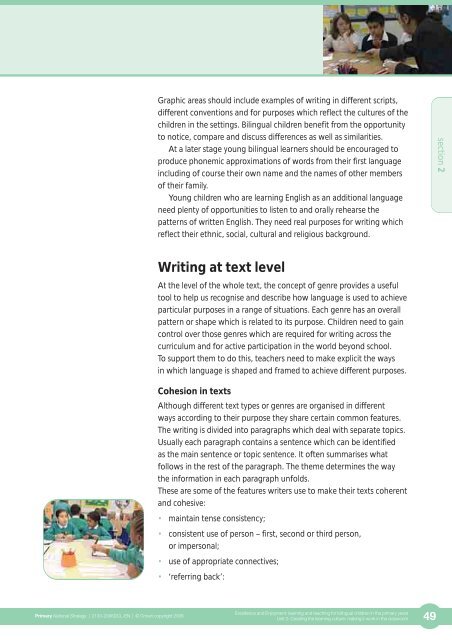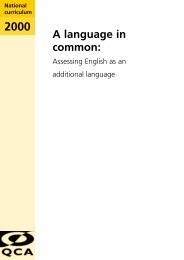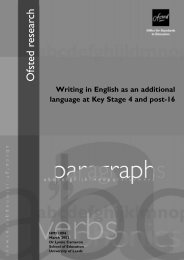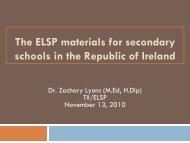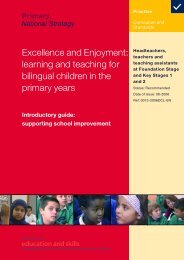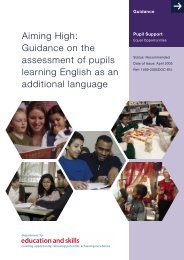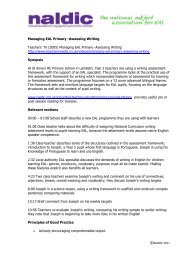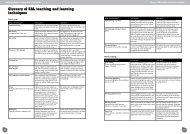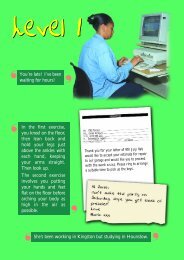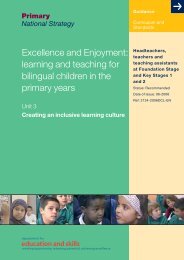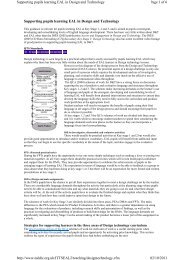Creating a learning culture: Making it work in the classroom - NALDIC
Creating a learning culture: Making it work in the classroom - NALDIC
Creating a learning culture: Making it work in the classroom - NALDIC
You also want an ePaper? Increase the reach of your titles
YUMPU automatically turns print PDFs into web optimized ePapers that Google loves.
Graphic areas should <strong>in</strong>clude examples of wr<strong>it</strong><strong>in</strong>g <strong>in</strong> different scripts,different conventions and for purposes which reflect <strong>the</strong> <strong>culture</strong>s of <strong>the</strong>children <strong>in</strong> <strong>the</strong> sett<strong>in</strong>gs. Bil<strong>in</strong>gual children benef<strong>it</strong> from <strong>the</strong> opportun<strong>it</strong>yto notice, compare and discuss differences as well as similar<strong>it</strong>ies.At a later stage young bil<strong>in</strong>gual learners should be encouraged toproduce phonemic approximations of words from <strong>the</strong>ir first language<strong>in</strong>clud<strong>in</strong>g of course <strong>the</strong>ir own name and <strong>the</strong> names of o<strong>the</strong>r membersof <strong>the</strong>ir family.Young children who are <strong>learn<strong>in</strong>g</strong> English as an add<strong>it</strong>ional languageneed plenty of opportun<strong>it</strong>ies to listen to and orally rehearse <strong>the</strong>patterns of wr<strong>it</strong>ten English. They need real purposes for wr<strong>it</strong><strong>in</strong>g whichreflect <strong>the</strong>ir ethnic, social, cultural and religious background.section 2Wr<strong>it</strong><strong>in</strong>g at text levelAt <strong>the</strong> level of <strong>the</strong> whole text, <strong>the</strong> concept of genre provides a usefultool to help us recognise and describe how language is used to achieveparticular purposes <strong>in</strong> a range of s<strong>it</strong>uations. Each genre has an overallpattern or shape which is related to <strong>it</strong>s purpose. Children need to ga<strong>in</strong>control over those genres which are required for wr<strong>it</strong><strong>in</strong>g across <strong>the</strong>curriculum and for active participation <strong>in</strong> <strong>the</strong> world beyond school.To support <strong>the</strong>m to do this, teachers need to make explic<strong>it</strong> <strong>the</strong> ways<strong>in</strong> which language is shaped and framed to achieve different purposes.Cohesion <strong>in</strong> textsAlthough different text types or genres are organised <strong>in</strong> differentways accord<strong>in</strong>g to <strong>the</strong>ir purpose <strong>the</strong>y share certa<strong>in</strong> common features.The wr<strong>it</strong><strong>in</strong>g is divided <strong>in</strong>to paragraphs which deal w<strong>it</strong>h separate topics.Usually each paragraph conta<strong>in</strong>s a sentence which can be identifiedas <strong>the</strong> ma<strong>in</strong> sentence or topic sentence. It often summarises whatfollows <strong>in</strong> <strong>the</strong> rest of <strong>the</strong> paragraph. The <strong>the</strong>me determ<strong>in</strong>es <strong>the</strong> way<strong>the</strong> <strong>in</strong>formation <strong>in</strong> each paragraph unfolds.These are some of <strong>the</strong> features wr<strong>it</strong>ers use to make <strong>the</strong>ir texts coherentand cohesive:• ma<strong>in</strong>ta<strong>in</strong> tense consistency;• consistent use of person – first, second or third person,or impersonal;• use of appropriate connectives;• ‘referr<strong>in</strong>g back’:Primary National Strategy | 2133-2006DCL-EN | © Crown copyright 2006Excellence and Enjoyment: <strong>learn<strong>in</strong>g</strong> and teach<strong>in</strong>g for bil<strong>in</strong>gual children <strong>in</strong> <strong>the</strong> primary yearsUn<strong>it</strong> 2: <strong>Creat<strong>in</strong>g</strong> <strong>the</strong> <strong>learn<strong>in</strong>g</strong> <strong>culture</strong>: mak<strong>in</strong>g <strong>it</strong> <strong>work</strong> <strong>in</strong> <strong>the</strong> <strong>classroom</strong> 49


